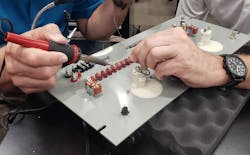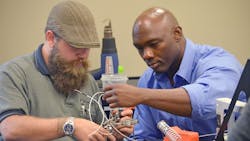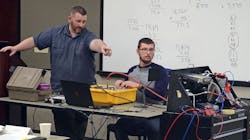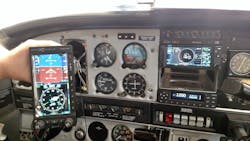How to Teach Troubleshooting (Without the Trouble)
Crucial across the entire field of aviation maintenance, troubleshooting is a skill any good technician needs to have and maintain. As both smart technologies and products built with planned obsolescence in mind increasingly enter every corner of society, troubleshooting skills can start to dull or fail to properly develop at all.
Nick Brown, Aircraft Electronics Association director of workforce development, has noticed newer technicians are not always equipped with these skills.
“We seem to live in a throw-away society where the value of fixing things has been lost in the last few generations. The good news is that there are still a lot of younger people that are growing up working with their hands and already have a strong foundation to become a great technician,” Brown said.
Fortunately, these skills can be taught and new technicians and those who’ve grown rusty can be problem solving like the pros in little time.
Back to Basics
Just how important is knowing how to troubleshoot? Brown describes it as “indispensable” knowledge.
“In the ever-evolving landscape of avionics, where new technologies are constantly introduced, troubleshooting skills are not just important; they are indispensable. These skills ensure that technicians can adapt to new systems and maintain high standards of safety and reliability,” he said.
Brown looks at troubleshooting like solving a puzzle.
“It's not just about fixing what's broken; it's about understanding why it broke, how it impacts the overall aircraft, and ensuring it doesn’t happen again. This requires a blend of electronics knowledge, experience, and creative problem-solving,” he said.
The key step is understanding how a system works, added Michael Studley, director field support engineering, Aspen Avionics. Once technicians understand the system that they’re working on, they can begin defining the problem.
Once there’s a clear understanding of what the problem or the reported problem is, then the problem should be verified, he said. Troubleshooting follows.
“I typically divide the system in half. If [the problem] could occur between Point A and Point B, I like to break it up in the middle and attack Point A first, confirm that's working correctly, and then move on to Point B,” continued Studley.
While Studley today specializes in avionics, he said while working with a regional airline, he would use this cross-disciple approach to lend mechanics a hand when needed.
“The mechanics would come to the avionics shop because we were the troubleshooters. There were a few that could troubleshoot, but mainly they just swapped parts. But if they swapped a part and it didn't fix the problem, they'd come to us,” he said.
That meant Studley could be working on a traffic collision avoidance system one day, and flaps or landing gear the next. Prior to then, he had never had any experience with these systems or parts. He described his strategy was to open the maintenance manual, read the “little blurb” in the beginning about the theory of operation and how the different components function.
“I could get a basic understanding of what was going on in the system and then make a plan from there,” he said.
These principles, along with troubleshooting in general, have become more important as technology has advanced.
“The things that were valid steps decades ago don't really translate over. There's so much software involved and high speed data. It's not just a wire from Point A to Point B, it's that wire has to work perfectly if it's a data bus. So, some of the basic skills – just to check a wire from end to end, sure, that's important – but that's not the whole story. That wire has to actually perform differently than when it's a high speed data bus than it would if it was just a DC signal from days gone by,” said Studley
Teaching The Skills
The first step is to help new technicians establish a good foundation built in whatever system a person is working on. In the example of avionics, it’s electronics.
“The NCATT AET certification is a great standard to start with. After that, it’s just a matter of practicing the knowledge, skills and abilities you’ve learned,” said Brown.
Studley added it's important that anyone going to work in avionics – or on any electrical – system get the basic training then expand their knowledge.
“So that they understand, ‘Well, when I'm going to go look at a wire from Point A to Point B, what else do I need to consider?’ The overall knowledge is hugely helpful when they're working on something, even if it's down to something as simple as a wire or a light or a heading system. Anything. You have to understand what you're working on first and how it works, and then move on to the troubleshooting step,” Studley continued.
For new technician, Brown said a lack of experience and confidence can be daunting for them at first. To combat this, Studley recommends utilizing a basic learning tool he used while working toward his A&P.
“We had probably a 2-foot by 2-foot plywood box, and it had the mockup of a flap system or of a landing gear system. On the side of the box, there was seven or eight toggle switches. With each one of those switches, you could induce a problem in the circuit that would mimic what you would see in a real aircraft. And that was hugely helpful.” Studley described.
He said the experience practicing on the dummy box helped him secure his job with the airline, as part of his interview was to demonstrate his knowledge on a similar dummy unit.
“I was glad that I had experience with a box like that because it made it easy. But that was a very effective way to give examples of problems and force you to troubleshoot the problem. If I was hiring somebody today, then I would probably have something like that,” he said.
However, Brown warns that new technicians may over-rely on diagnostic tools, but having experienced avionics technicians mentor them can balance this by demonstrating the art of troubleshooting and encouraging a deeper understanding of avionics systems beyond the basics.
Studley gave an example of this from his early days inavionics, when he and his crew couldn’t solve the problem with an auto pilot system. He said there was a suspicion that a wire was broken, and the go-to was to grab a digital multimeter, but it showed everything as normal.
“We struggled for a couple hours trying to figure out what else it could be. And there is an old-timer that was new to our location. He walks over and he pulls out an old Simpson 260, which is an old analog fault meter. He used that to check the same wire, and that showed a problem that the digital meters didn’t show because the old meter would supply some real current.
“And what it was is that there was a very high resistance connection in that wire that the digital meters didn't find because they weren't putting any real current through it. We had it fixed in 30 minutes once he schooled us on that,” Studley recalled.
Tribal knowledge, he noted, is a double-edged sword, though, and on the whole, he recommends new technicians stay away from hearsay posing as wisdom.
“Stay away from tribal knowledge because that can take you down all kinds of wrong avenues when you're troubleshooting a system,” he continued. “They think they know how it works because they've heard something or some other guy told them about it, etc. They make assumptions. Just stick with the same principles of learning how it actually works.”
Studley, as part of his current role with Aspen, helps troubleshoot and guide people over the phone when they run into an issue. He encourages technicians stuck on a problem to contact system authorities like himself who can walk them through the correct way to a solution, which avoids the pitfalls of going to a possible unreliable source and will help establish the knowledge base they need by speaking one-on-one with a technical expert.
In fact, the most important lessons to ensure a new technician develops troubleshooting skills the basics, said Brown, such as electrical theory, using a multimeter, and system integration.
“They must also be skilled at reading manuals and writing diagrams accurately. Additionally, a thorough understanding of the 'divide and conquer' approach, which involves breaking down complex systems into manageable sections, is crucial,” he continued.
Studley agreed, adding while it might seem repetitive, have that solid knowledgebase is the most crucial “tool” for any technician to have when they go to troubleshoot a system.
“I hate to harp on the same thing over and over again, but those initial steps that I talked about, where you understand the system, understand the problem, and then prove the problem exists, and it's not something else, and then start the troubleshooting. I think that's really the most helpful tips I'd offer anybody,” he Studley said.
About the Author
Walker Jaroch
Editor
Contact: Walker Jaroch
Editor | AMT
+1-920-568-8399
>> To download the AviationPros media kits, visit: Marketing Resource Center
>>Check out our aviation magazines: Ground Support Worldwide | Airport Business | Aircraft Maintenance Technology





